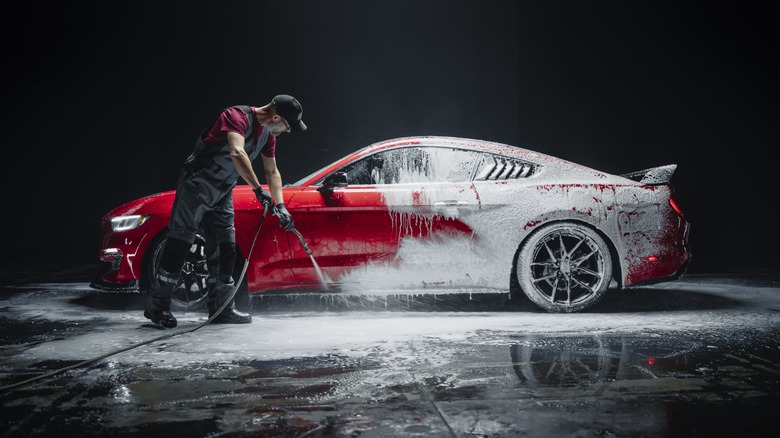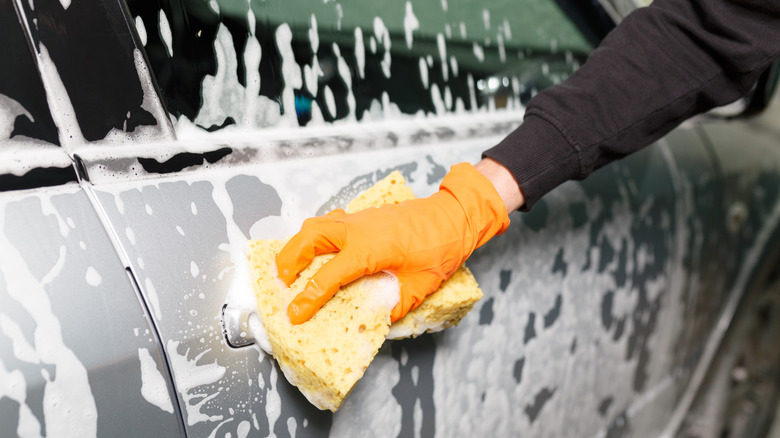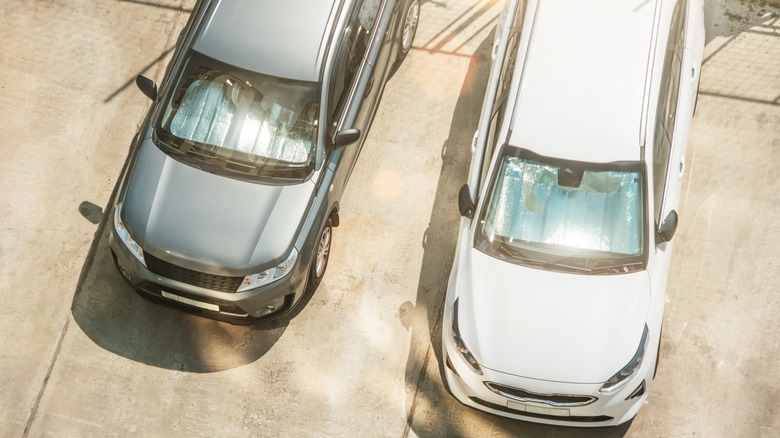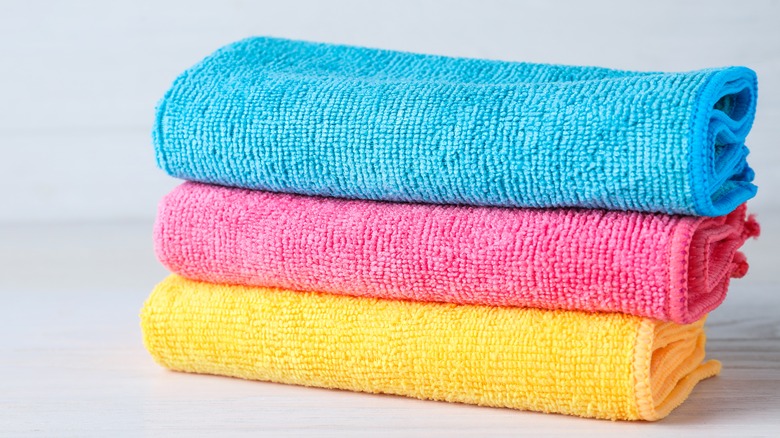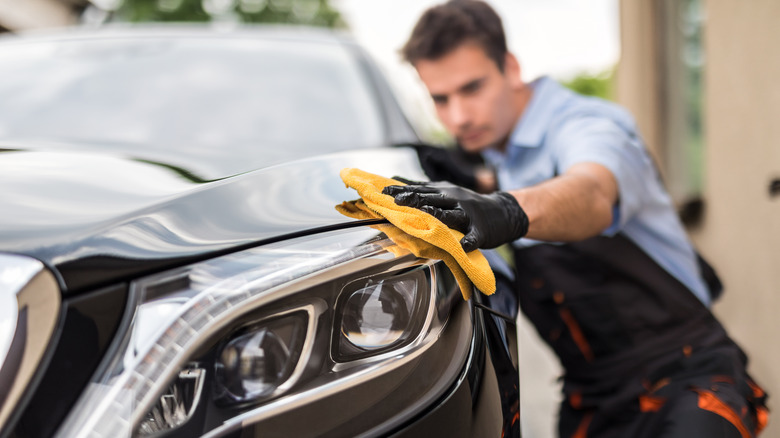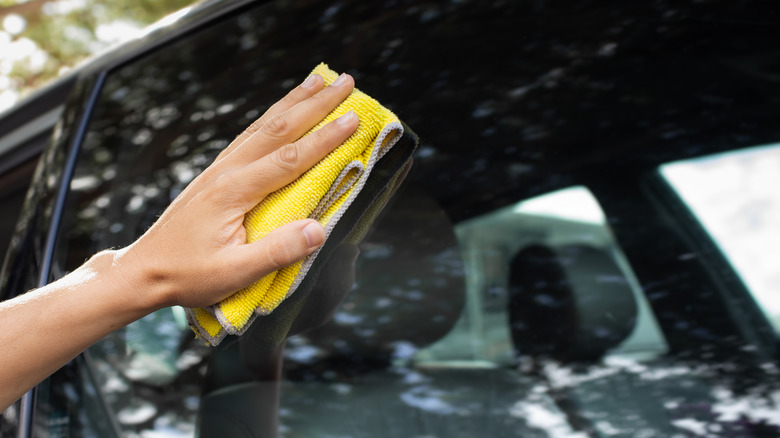5 Big Mistakes To Avoid When Cleaning Your Car
Car ownership is a source of pride, but keeping it looking new takes dedication, the right tools, and regular cleaning habits. It's good practice to keep up with periodic oil changes, brake inspections, and coolant top-ups every 5,000 to 8,000 miles. However, neglecting regular car washes, waxing, and detailing will make any car look old and dated, regardless of the model year.
Then again, cars are not like clothes or ceramic dinner plates that require strong detergents or dish soap to keep them clean. On the other hand, using the wrong chemicals or cleaning products could do more harm than good. For instance, washing your car with dish soap is a surefire way to remove deep-seated dirt and contaminants from paint, rubber, glass, and plastic surfaces. Still, it'll also dissolve the protective layer of wax on the clear coat, leaving the paint vulnerable to UV exposure, acid rain, and other nasty things that will deteriorate the finish.
Besides, washing a vehicle with dish soap will lead to accelerated wear and tear on chrome, rubber, plastic, and other non-painted surfaces. It's a similar case with powdered or liquid detergent that, although fantastic at removing dirt, mud, and grime, is too harsh for delicate surfaces like clear-coat paint, chrome, and glass. Not using dish soap or household detergents is a good start, but here are the top five things to avoid when cleaning any car.
Not washing frequently
Do not wait for seasons to end before washing your vehicle. Unless we're talking about garage queens who only see the light of day in hot summers, periodic washing is essential to maintain the brand-new look of your ride.
Moreover, frequent washing or rinsing prevents rust and corrosion during salty winters. Regularly spraying the undercarriage with clean water when the weather is cold will remove corrosive road salts from ruining your car's chassis, suspension, and brakes.
Make it a habit to wash your vehicle at least once a week, especially if you park in open areas. The same adage applies to older cars with decent-looking paint. The more you wash, the easier it is to remove imperfections like oxidation, light scratches, stains, or swirl marks.
Rinse the entire vehicle with clean water before washing it with car shampoo. Washing from top to bottom is a good practice to prevent scratching or swirling the paint. Start washing the roof, hood, and trunk before moving to the windows, doors, bumpers, and fenders. Wash the wheels and tires using a separate cleaner and sponge.
Washing under the hot sun
Do not wash a car under direct sunlight. Although sometimes impractical, washing a car in the shade is better and comfier than nuking it out under the sun. Higher temperatures could prematurely dry the car wash foam and lead to spotting or stains, which might need paint correction or polishing to remove.
In addition, prolonged sun exposure could harm or irritate your skin. It's preferable to park the vehicle in a shaded area before washing. On a similar note, avoid washing a hot car. Let it cool for at least an hour before washing with car shampoo and water. Depending on where you live, the best times to wash a car are early mornings or mid-afternoons.
The same rule applies if you plan to polish or wax the paint after washing. Most car care products are for cool surfaces and should only be applied in the shade. Read the label before applying anything to your car's paint.
Not segregating your cleaning tools
Do not use towels or sponges for cleaning wheels to wipe the paint. It's better to have separate towels for washing, drying, and wiping the wheels and tires. The lower parts of your vehicle are closest to the road and are the dirtiest. Wiping the paint with a towel you used to clean the wheels is a surefire way to dull and scratch the finish.
It doesn't matter if you wash the wheels and tires before or after washing the body. More important is to use separate tools (sponge, brush, and cleaning solution) to wash the wheels. Never wipe the car's body using a cloth previously used to wipe the wheels or tires to prevent scratches from ruining your car's paint.
The trick is to color-code towels for washing, drying, and detailing. Another tip is to have a separate towel to wipe all glass surfaces. Doing so prevents cross-contamination between surfaces and lessens the chances of scratching the finish.
Wiping dry paint with a dry towel
Never use a dry towel or a feather duster to remove dust or light dirt. Wiping paint, glass, or plastic with a dry towel introduces more harmful friction that could scratch or damage the surface. Dry-washing a car takes skill, patience, and extreme attention to detail.
When cleaning or wiping painted surfaces, minimizing friction is the key to achieving a smooth, glossy finish. If you have no means to wash the car with water and foam, the least you can do is use a damp microfiber towel and a spray detailer to minimize friction when wiping. Spray the product directly on the paint and wipe it off with a mildly wet microfiber towel. This technique reduces friction while helping the towel pick up dirt and debris.
Moreover, consistent lubrication is required when using a clay bar to decontaminate the paint. Never use a clay bar when the paint is dry.
Using ammonia-based glass cleaners
The inside part of the windshield and windows should be clear and streak-free. However, glass (especially automotive glass) is notoriously tricky to clean. Using an old, contaminated rag or ammonia-based glass cleaners could do more harm than good. Not only could it scratch the delicate glass surface, but it can cause streaks and impede your vision of the road.
Ammonia-based glass cleaners emit harmful fumes and could prematurely deteriorate the appearance of plastic and rubber parts. If your car has tinted windows, the ammonia in glass cleaners could fade, scratch, or peel the tint. When choosing a glass cleaner for your vehicle, use a product with zero ammonia and a dedicated microfiber towel to avoid streaking.
Maintaining a clean and decent-looking ride is not just about bragging rights. Periodic care and maintenance help preserve any car's resale value, and regular cleaning is another step worth considering.
